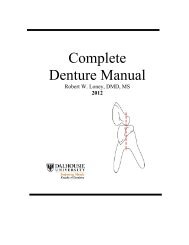RPD Manual 11 - Removable Prosthodontics - Dalhousie University
RPD Manual 11 - Removable Prosthodontics - Dalhousie University
RPD Manual 11 - Removable Prosthodontics - Dalhousie University
You also want an ePaper? Increase the reach of your titles
YUMPU automatically turns print PDFs into web optimized ePapers that Google loves.
Direct Retainers For Tooth and Tissue Borne <strong>RPD</strong>'s<br />
Direct and Indirect Retainers - 49<br />
Tooth and tissue borne situations (Class I & II) require special attention in direct retainer<br />
selection, due to stresses created by rotational movements of the prostheses. When the denture<br />
bases are placed under function, rotation occurs about the rest seats of the most posterior<br />
abutments. Excessive occlusal forces on the distal-extension portion of the denture could cause<br />
a torquing action on the abutment teeth unless direct retainers are designed with stress-breaking<br />
capabilities. Stress releasing clasp assemblies include:<br />
1. the bar clasp with mesial rest (e.g. RPI)<br />
2. the RPA clasp<br />
3. the combination clasp<br />
1. Bar Clasps<br />
a. The bar clasp is a cast clasp that arises from the partial denture framework and approaches<br />
the retentive undercut from gingival direction (as opposed to a circumferential clasp that<br />
approaches the undercut from the occlusal direction).<br />
b. Retentive clasps are identified by shape of retentive terminal, i.e. T, Y, L, I, U, and S.<br />
c. The shape is unimportant as long as the direct retainer is mechanically and functionally<br />
stable, covers minimal tooth structure with minimum display (the I bar most often meets<br />
these requirements)<br />
d. T-and Y-shaped terminal ends are the most misused clasps. The full area coverage of the T<br />
and Y terminal ends is rarely necessary for adequate retention.<br />
e. L-shaped clasp is same as an I clasp with a longer horizontal component. The U-shaped<br />
clasp is same as an L-shaped clasp with a terminal like a double I-clasp.<br />
f. The S-shaped terminal end is used to avoid a mesial soft tissue undercut.<br />
g. Soft tissue relief is provided under the approach arm with 28 or 30 gauge wax, to prevent<br />
tissue impingement<br />
Contraindications:<br />
a) deep cervical undercuts - food trap or impingements result<br />
b) severe soft tissue or bony undercuts - food trap or impingements result















